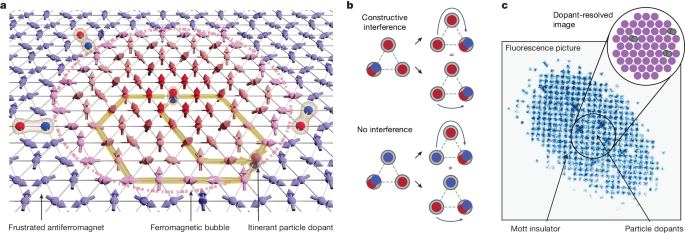Microscopic Observation of Nagaoka Polarons in a Fermi-Hubbard Quantum Simulator
Основні поняття
Quantum interference can deeply alter the nature of many-body phases of matter, and the introduction of a single itinerant charge can transform a paramagnetic insulator into a ferromagnet through path interference, as demonstrated by the emergence of Nagaoka polarons in a Hubbard system realized with strongly interacting fermions in a triangular optical lattice.
Анотація
The content describes the experimental observation of Nagaoka polarons, which are extended ferromagnetic bubbles that form around particle dopants in a Fermi-Hubbard system due to the local interplay of coherent dopant motion and spin exchange. The authors used a quantum gas microscopy technique to directly image these polarons in a triangular optical lattice.
The key highlights are:
Quantum interference can deeply alter the nature of many-body phases of matter.
Nagaoka proved that introducing a single itinerant charge can transform a paramagnetic insulator into a ferromagnet through path interference.
The authors realized a Hubbard system with strongly interacting fermions in a triangular optical lattice and observed the emergence of Nagaoka polarons.
The Nagaoka polarons appear as extended ferromagnetic bubbles around particle dopants, arising from the local interplay of coherent dopant motion and spin exchange.
In contrast, kinetic frustration due to the triangular geometry promotes antiferromagnetic polarons around hole dopants.
This work enables the exploration of exotic quantum phases driven by charge motion in strongly correlated systems, which is challenging for numerical simulation.
Observation of Nagaoka polarons in a Fermi–Hubbard quantum simulator - Nature
Статистика
Quantum interference can deeply alter the nature of many-body phases of matter.
Introducing a single itinerant charge can transform a paramagnetic insulator into a ferromagnet through path interference.
The authors realized a Hubbard system with strongly interacting fermions in a triangular optical lattice.
Цитати
"Quantum interference can deeply alter the nature of many-body phases of matter1."
"In the case of the Hubbard model, Nagaoka proved that introducing a single itinerant charge can transform a paramagnetic insulator into a ferromagnet through path interference2,3,4."
"Here we demonstrate the emergence of Nagaoka polarons in a Hubbard system realized with strongly interacting fermions in a triangular optical lattice5,6."
Ключові висновки, отримані з
by Martin Lebra... о www.nature.com 05-08-2024
https://www.nature.com/articles/s41586-024-07272-9
Глибші Запити
How can the insights from the observation of Nagaoka polarons be leveraged to engineer novel quantum phases in other strongly correlated systems?
The observation of Nagaoka polarons in a Hubbard system provides valuable insights into the role of charge motion in driving exotic quantum phases in strongly correlated systems. By understanding how a single itinerant charge can induce ferromagnetism through path interference, researchers can apply this knowledge to engineer novel quantum phases in other systems. For example, by manipulating the interplay between coherent dopant motion and spin exchange, similar kinetic magnetism effects could be harnessed to create tailored quantum states with specific properties. This could lead to the design of materials with desired magnetic or electronic characteristics, opening up possibilities for quantum technologies and devices.
What are the limitations of the triangular optical lattice setup in fully capturing the dynamics of Nagaoka polarons, and how could alternative lattice geometries or dimensionalities provide additional insights?
While the triangular optical lattice setup offers a platform to study Nagaoka polarons, it has limitations in fully capturing their dynamics due to the specific geometry and constraints of the lattice. The triangular lattice may introduce kinetic frustration that favors antiferromagnetic polarons around hole dopants, limiting the observation of certain ferromagnetic behaviors. To overcome these limitations and gain additional insights, alternative lattice geometries or dimensionalities could be explored. For instance, using square or honeycomb lattices may provide different environments for studying Nagaoka polarons and uncovering new aspects of their behavior. By varying the lattice structure, researchers can investigate how different geometries impact the emergence and properties of polarons, enhancing our understanding of these quantum phenomena.
Given the challenges of numerical simulation for these strongly correlated systems, how can the experimental observations of Nagaoka polarons inform the development of new theoretical and computational approaches to model and predict the emergence of exotic quantum phases?
The experimental observations of Nagaoka polarons offer a valuable opportunity to inform the development of new theoretical and computational approaches for modeling strongly correlated systems and predicting the emergence of exotic quantum phases. By directly observing the behavior of polarons in a Hubbard system, researchers can gather crucial data to validate and refine existing theoretical models. These experimental insights can guide the development of more accurate computational methods that take into account the complex interplay of charge motion, spin exchange, and lattice effects in predicting quantum phases. Additionally, experimental observations can inspire the creation of innovative theoretical frameworks that capture the dynamics of Nagaoka polarons and other related phenomena, leading to a deeper understanding of quantum materials and paving the way for the discovery of novel quantum phases.
0
